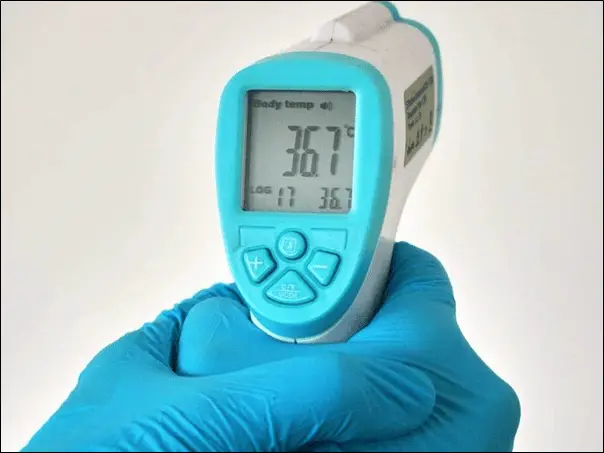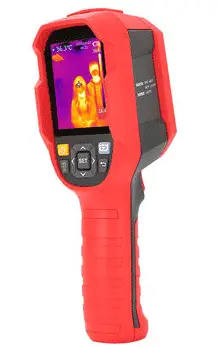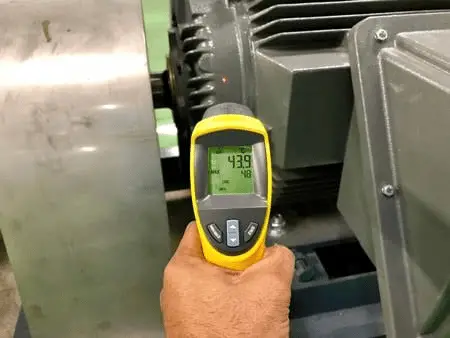We will discuss the working of infrared thermometers in this post. The infrared thermometer is an instrument that measures the temperature of a hot object or body. Infrared (IR) thermometers find wide applications in temperature measurement across a range of industrial and clinical environments.
These non-contact temperature measurement devices are the most suitable for measuring the temperature of the objects that are fragile and dangerous to get near to, or when it is not impossible to measure temperature with other kinds of thermometers.
A laser thermometer is another name for an infrared thermometer. A laser measures the temperature of a target using a temperature gun through non-contact means from a distance.
Working of Infrared Thermometers
An infrared thermometer measures the amount of infrared energy emitted by the object or body or material. The emitted energy depends on the material’s emissivity and the temperature. An infrared thermometer measures the radiation emitted from the hot object. Therefore, it is a kind of radiation thermometer.

An infrared thermometer contains a focusing lens that focuses on infrared thermal radiation emitted by the target. The infrared detector, also known as a thermopile, receives the radiation energy and converts the radiation energy into an electrical signal.
Further, the processor of the thermometer receives the electrical signal. The camera processor creates a color map of the apparent temperature of the target using a mathematical algorithm. Each temperature value has a different color. Thus, the color spectrum shows the temperature of individual particles of an object.
The memory stores the measured color spectrum and compares it to a prefeed color spectrum. Then, the thermometer outputs the temperature readings on the display for user.
How to use Infrared Thermometer?
The measurement accuracy depends on the distance between the infrared thermometer and the hot object. Thus, the infrared thermometer’s measuring accuracy is user-dependent. The reason is different users may hold the infrared thermometer at different distances from the target, creating a variation in angular coverage.
One important term associated with infrared thermometers is the distance to spot ratio (D:S). Every infrared thermometer has its own D to S ratio. The D:S ratio tells how much the infrared thermometer should be far away from the target to measure the temperature of the object of a given diameter.
For example, If the IR thermometer with a 10:3 D:S ratio, then the infrared thermometer must be 10 units away from the object of size 3 units of diameter. Any variation in the D to S ratio leads to incorrect temperature measurement.
Typically, the D:S ratio varies from 1:1 to 60:1. The manufacturer displays the D:S ratio information in the operating manual. Therefore, it is a must to maintain the distance from the object while measuring the temperature for getting an accurate temperature.
The infrared thermometer shows two types of displays. One is direct temperature and the other is the thermal image as shown below.
Direct temperature

Thermal image

Precautions while using Infrared Thermometer
While measuring the temperature of bright shiny surfaces, care must be taken because this type of surface is very reflective, and can be very challenging in terms of temperature measurement through an infrared thermometer.
In order to measure the temperature of such bright shiny surfaces using an infrared thermometer, a piece of non-reflective tape such as electrical tape is applied over the shiny surface.
Temperature measurement with the infrared thermometer becomes difficult when there is dust or fog or steam in between the target object and the infrared thermometer. Also, the infrared thermometer gives erroneous temperature readings if there are moisture particles deposited on the lens.
If the lens of the infrared thermometer is having some scratches, then it also give the incorrect temperature reading. In such a case, the replacement of the lens is the only solution.
Whenever measuring the temperature of a target, always hold the infrared thermometer standstill and always take 2-3 readings for the same target to get more accurate readings.
What is the best way to use Infrared Thermometer?
General practice and the best one to get accurate results using an infrared thermometer is to keep the infrared thermometer in the area where temperature measurement is to be done (NOTE: Not to be followed in too high or too low temperatures) and allow the temperature of infrared thermometer to come to the temperature of its surrounding. This will take approximately 15 to 20 minutes.
Always hold the infrared thermometer still because movements during the temperature measurement of a target can lead to inaccurate readings.
Always store the infrared thermometer in cool areas and cover the lens so that lens remains scratch-free because the lens is the most important part of the infrared thermometer.
Applications of Infrared Thermometers

- To measure the temperature of components (power supply units, IO cards, relays, etc) installed in a panel (in rack room or substation or analyzer room) to know their healthiness and know whether the panel is having sufficient cooling or not.
- To measure the temperature of running equipment like the pump or compressor during LLF round.
- For temperature measurement of transmitters installed near some hot service line like a steam line. In the case of high temperatures in temperature transmitters, the electronic devices are apt to fail. Therefore, it helps in deciding the new location of the transmitter.it is possible to change the mounting location of the transmitters.
- To know the temperature of a person, the best example of this is temperature measurement during the COID-19 pandemic.
- To regularly monitor heating and air conditioning and detect insulation breakdown/heat loss/duct leakage
- For verification of the condition of storage in truck or storage area where food is going to be stored.
- To monitor plant temperatures for better growth.
Read Next: